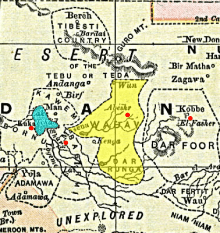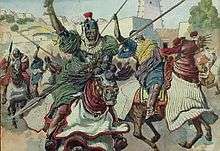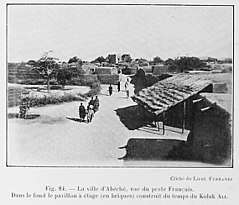Wadai Empire
The Wadai Sultanate (Arabic: سلطنة وداي Saltanat Waday, French: royaume du Ouaddaï, Fur: Burgu or Birgu;[1] 1501–1912) was an African sultanate located to the east of Lake Chad in present-day Chad and the Central African Republic. It emerged in the seventeenth century under the leadership of the first sultan, Abd al-Karim, who overthrew the ruling Tunjur people of the area. It occupied land previously held by the Sultanate of Darfur (in present-day Sudan) to the northeast of the Sultanate of Baguirmi.
Sultanate of Wadai سلطنة وداي | |||||||||||
|---|---|---|---|---|---|---|---|---|---|---|---|
| 1501–1912 | |||||||||||
 Wadai and surrounding states in 1750. | |||||||||||
| Capital |
| ||||||||||
| Common languages | Arabic, Maban, Tunjur, Fur | ||||||||||
| Religion | Traditional African religion, later Islam (official 1635) | ||||||||||
| Government | Monarchy | ||||||||||
| Kolak | |||||||||||
• 1603–1637 | Abd al-Karim Al Abbasi | ||||||||||
• 1902–1909 | Dud Murra of Wadai | ||||||||||
• 1909-1912 | 'Asil Kolak | ||||||||||
| Historical era | Early Modern Period | ||||||||||
• Established | 1501 | ||||||||||
• Abd al-Karim overthrows the Tunjur King Daud | 1635 | ||||||||||
• Disestablished | 1912 | ||||||||||
• Wadai reconstituted under French suzerainty | 1935 | ||||||||||
| |||||||||||
| Today part of | |||||||||||
Part of a series on the |
|---|
| History of Chad |
 |
|
History
Origins
Prior to the 1630s, Wadai, also known as Burgu to the people of Darfur, was a pre-Islamic Tunjur kingdom, established around 1501.[2] The Arab migrants to the area which became Wadai claimed to be descendants of the Abbasid Caliphs, specifically from Salih ibn Abdallah ibn Abbas. Yame, an Abbasid leader, settled with Arab migrants in Debba, near the future capital of Ouara (Wara).[1]
In 1635, the Maba and other small groups in the region rallied to the Islamic banner of Abd al-Karim Al Abbasi, who was descended from an Abbasid noble family, led an invasion from the east and overthrew the ruling Tunjur group, who at the time was led by a king named Daud. Abd al-Karim was the son of Yame the Abbasid.[1] Abd al-Karim secured and centralized his power in the area by marrying the Tunjur King Daud's daughter, Meiram Aisa, and then forming other marriage pacts with local dynasties and tribes, such as the Mahamid and Beni Halba tribes. Abd al-Karim became the first Kolak (Sultan) of a dynasty that lasted until the arrival of the French.
During much of the 18th century, the history of Wadai is marked by wars with the Sultanate of Darfur and in the early 1700s under the rule of Abd al-Karim's grandson, Ya'qub Arus (1681–1707), the country suffered terrible drought that lasted for several years.
Expansion

After 1804, during the reign of Muhammad Sabun (r. 1804 – c. 1815), the Sultanate of Wadai began to expand its power as it profited considerably from its strategic position astride the trans-Saharan trade routes. A new trade route to the north was found, via Ennedi, Kufra and Jalu-Awjila to Benghazi, and Sabun outfitted royal caravans to take advantage of it. He began minting his own coinage and imported chain mail, firearms, and military advisers from North Africa. Sabun's successors were less able than he, and Darfur took advantage of a disputed political succession in 1838 to put its own candidate in power in Ouara, the capital of Wadai. This tactic backfired, however, when Darfur's choice, Muhammad Sharif, rejected Darfur's meddling and asserted his own authority. In doing so, he gained acceptance from Wadai's various factions and went on to become Wadai's ablest ruler.
Sharif conducted military campaigns as far west as Bornu and eventually established Wadai's hegemony over Baguirmi and kingdoms as far away as the Chari River. In Mecca, Sharif had met the founder of the Senussi Islamic brotherhood, a movement that was strong among the inhabitants of Cyrenaica (in present-day Libya) and that was to become a dominant political force and source of resistance to French colonization.
Decline


Sultan Dud Murra of Wadai opposed French domination until being overcome on June 6, 1909, with the occupation of the capital Abéché by French troops where a puppet sultan was installed. Resistance continued until the last independent sultan, 'Asil Kolak, was captured in 1912 bringing the independence of the sultanate to an end.
The Wadai Sultanate was reconstituted under French suzerainty in 1935, with Muhammad Urada ibn Ibrahim becoming Kolak, or sultan. The sultanate continues under the suzerainty of the Republic of Chad and its current Kolak since 1977 is Ibrahim ibn Muhammad Urada.
It became part of the independent Republic of Chad on that country's independence in 1960. The Ouaddaï Region of modern Chad covers part of the area of the old kingdom. Its chief town is Abéché.
See also
- Rulers of the Wadai Kingdom
- Dar al Kuti
References
- Nachtigal, G. (1971). Sahara and Sudan: Kawar, Bornu, Kanem, Borku, Enned. Sahara and Sudan. University of California Press. p. 206. ISBN 978-0-520-01789-4. Retrieved 2018-10-10.
- https://www.britannica.com/place/Wadai
External links
- www.waddai.com (in Arabic)